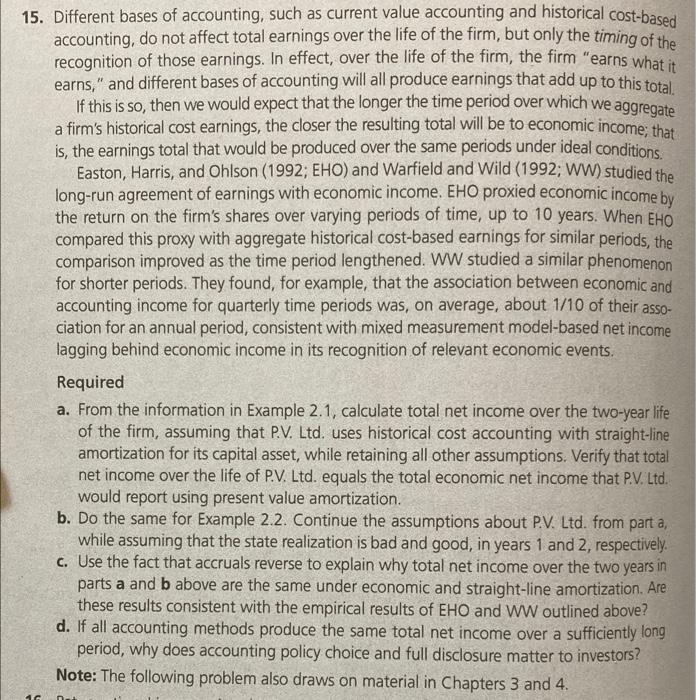Answered step by step
Verified Expert Solution
Question
1 Approved Answer
please help me with explanation a 15. Different bases of accounting, such as current value accounting and historical cost-based accounting, do not affect total earnings
please help me with explanation 
a 15. Different bases of accounting, such as current value accounting and historical cost-based accounting, do not affect total earnings over the life of the firm, but only the timing of the recognition of those earnings. In effect, over the life of the firm, the firm "earns what it earns," and different bases of accounting will all produce earnings that add up to this total If this is so, then we would expect that the longer the time period over which we aggregate a firm's historical cost earnings, the closer the resulting total will be to economic income; that is, the earnings total that would be produced over the same periods under ideal conditions Easton, Harris, and Ohlson (1992; EHO) and Warfield and Wild (1992; WW) studied the long-run agreement of earnings with economic income. EHO proxied economic income by the return on the firm's shares over varying periods of time, up to 10 years. When EHO compared this proxy with aggregate historical cost-based earnings for similar periods, the comparison improved as the time period lengthened. WW studied a similar phenomenon for shorter periods. They found, for example, that the association between economic and accounting income for quarterly time periods was, on average, about 1/10 of their asso- ciation for an annual period, consistent with mixed measurement model-based net income lagging behind economic income in its recognition of relevant economic events. Required a. From the information in Example 2.1, calculate total net income over the two-year life of the firm, assuming that P.V. Ltd. uses historical cost accounting with straight-line amortization for its capital asset, while retaining all other assumptions. Verify that total net income over the life of P.V. Ltd. equals the total economic net income that P.V. Ltd. would report using present value amortization. b. Do the same for Example 2.2. Continue the assumptions about P.V. Ltd. from part a, while assuming that the state realization is bad and good, in years 1 and 2, respectively. c. Use the fact that accruals reverse to explain why total net income over the two years in parts a and b above are the same under economic and straight-line amortization. Are these results consistent with the empirical results of EHO and WW outlined above? d. If all accounting methods produce the same total net income over a sufficiently long period, why does accounting policy choice and full disclosure matter to investors? Note: The following problem also draws on material in Chapters 3 and 4. 10 a 15. Different bases of accounting, such as current value accounting and historical cost-based accounting, do not affect total earnings over the life of the firm, but only the timing of the recognition of those earnings. In effect, over the life of the firm, the firm "earns what it earns," and different bases of accounting will all produce earnings that add up to this total If this is so, then we would expect that the longer the time period over which we aggregate a firm's historical cost earnings, the closer the resulting total will be to economic income; that is, the earnings total that would be produced over the same periods under ideal conditions Easton, Harris, and Ohlson (1992; EHO) and Warfield and Wild (1992; WW) studied the long-run agreement of earnings with economic income. EHO proxied economic income by the return on the firm's shares over varying periods of time, up to 10 years. When EHO compared this proxy with aggregate historical cost-based earnings for similar periods, the comparison improved as the time period lengthened. WW studied a similar phenomenon for shorter periods. They found, for example, that the association between economic and accounting income for quarterly time periods was, on average, about 1/10 of their asso- ciation for an annual period, consistent with mixed measurement model-based net income lagging behind economic income in its recognition of relevant economic events. Required a. From the information in Example 2.1, calculate total net income over the two-year life of the firm, assuming that P.V. Ltd. uses historical cost accounting with straight-line amortization for its capital asset, while retaining all other assumptions. Verify that total net income over the life of P.V. Ltd. equals the total economic net income that P.V. Ltd. would report using present value amortization. b. Do the same for Example 2.2. Continue the assumptions about P.V. Ltd. from part a, while assuming that the state realization is bad and good, in years 1 and 2, respectively. c. Use the fact that accruals reverse to explain why total net income over the two years in parts a and b above are the same under economic and straight-line amortization. Are these results consistent with the empirical results of EHO and WW outlined above? d. If all accounting methods produce the same total net income over a sufficiently long period, why does accounting policy choice and full disclosure matter to investors? Note: The following problem also draws on material in Chapters 3 and 4. 10 
Step by Step Solution
There are 3 Steps involved in it
Step: 1

Get Instant Access to Expert-Tailored Solutions
See step-by-step solutions with expert insights and AI powered tools for academic success
Step: 2

Step: 3

Ace Your Homework with AI
Get the answers you need in no time with our AI-driven, step-by-step assistance
Get Started


